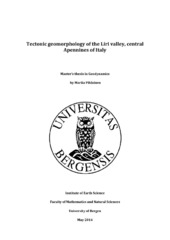| dc.description.abstract | This is a detailed study of hillside catchments in the Liri valley, central Apennines of Italy. Various geomorphic parameters extracted from a 20-m digital elevation model (DEM) are used to study the morphology of small drainage basins on two sides of the valley: one side exhibiting a normal fault and the other an old inactive thrust fault, both bounded by major lithological contacts. In addition, the axial Liri river is known to be incising. The area is in a highly unsteady state, therefore, the motivation behind this study is to understand the long-term evolution of channels in a tectonically active non-equilibrium landscape. The objective is to identify patterns and possible variations along strike, and try to point out possible explanations behind these changes. This is done by combining knowledge of the local geology and contrasting it against the theoretical analysis of long profiles. Based on a method widely used in tectono-geomorphic studies, channel drainage area is extracted from a DEM, and corresponding slopes are calculated along the extracted channel, after which these data are plotted in logarithmic slope-drainage area space, which yields the concavity (and steepness indices). The extracted values are then compared to what other studies have associated similar concavities with. The results show that the geomorphology is different between the two sides of the valley. The inactive B-side catchments are controlled mainly by lithology, showing low channel concavities (below 0.4) on the hillslopes and changing to a higher concavity where the streams reach the valley bottom sediments, and also exhibit knickpoints at the lithological boundaries. The active Liri fault side catchments seem to be responding more to catchment size: the small catchments exhibit knickpoints at the fault/ lithological boundary and have in general lower concavities, whereas the larger catchments are nonchalant to this contact and exhibit high concavities (much higher than 0.6). These very high values may be explained by the southern end of the Liri fault being inactive at present or that the slip rate is much lower than suggested. | en_US |
